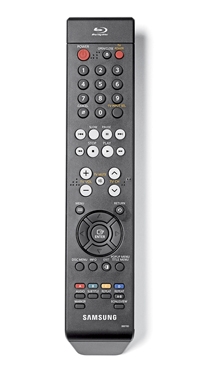Samsung BD-P1500 Blu-ray Disc Player Page 2
 |
PERFORMANCE
Before I started performing any of our video torture tests, I used the BD-P1500 to simply play movies for a while. And I found that, for the most part, it behaved well, with few of the frustrating problems that plagued some earlier players. At no point did I encounter a disc that wouldn't play at all, stopped halfway through, or locked up the Samsung player. Load times were generally fast, although some of the discs were sluggish. For example, a Bonus View disc like Sunshine took an agonizing 2 minutes and 16 seconds to load the menu screen, while my favorite quick-loading disc, A Clockwork Orange, was up and rolling in 35 seconds.
Once Sunshine was playing, I found that the Bonus View features worked seamlessly. Pressing a button in the bottom right corner of the remote brought up a small window with behind-the-scenes footage about how the film was made, along with accompanying commentary. That's certainly a step up from regular DVD commentary tracks where everyone just keeps saying how great each actor is as they appear onscreen.
Picture quality was hard to fault, with the Samsung delivering crisp detail, deep and noise-free blacks, and accurate color rendition. I did catch just a hint of moiré effects in the buildings at the start of Chapter 15 of Mission: Impossible III, although it was far less obvious than I've seen in the past with some other players. No Country for Old Men looked especially impressive, with exceptional delineation in the subtle hues of the desert landscapes.
Loading up the Blu-ray version of the Silicon Optix HD HQV Benchmark disc, I saw some flickering on both the Video and Film Resolution Loss test patterns, and just a hint of stair-step artifacts during the diagonal-filter Jaggies tests. Having said that, both the Film Resolution Loss test showing a slow pan across an empty stadium and the HD Noise Test showing a sailboat at sunset looked superb.
Using the regular DVD version of the same tests with the BD-P1500's video output set for 1080p over HDMI, the images looked smooth and were relatively noise-free, although it seemed like the player occasionally glossed over some of the finest details. Subtleties in both the fine brickwork from the Flag test and the grass in the bridge scene looked a bit smoothed out and lacking in definition. With no user-selectable noise-reduction controls, it's hard to tell exactly what the player was doing to the image - although setting its video output to 480i and using the HQV Reon processor in the Integra receiver to perform high-def upconversion resulted in a slight but clear improvement in picture detail. It's important to understand that these test images are carefully engineered to delineate tiny differences. Under regular movie-viewing conditions, the BD-P1500's picture always looked excellent.
BOTTOM LINE
As someone who has essentially zero interest in gaming, I'm frustrated that the leading Blu-ray player up to this point has essentially been a hijacked videogame console. Most earlier standalone Blu-ray players couldn't match the PS3's performance, or they cost so much that they failed to deliver good value. Now, with the Samsung BD-P1500, we finally have a "real" Blu-ray player that can deliver outstanding performance at an affordable price. No, it doesn't have interactive BD-Live capability, but to many people (myself included), those features are of minor importance next to things like basic video performance and disc handling - areas where the BD-P1500 excels. While the inclusion of DTS-HD Master Audio decoding and multichannel analog outputs would have certainly widened its appeal, when paired with the right receiver, those omissions become irrelevant. In some ways, the BD-P1500 shows us that Blu-ray has finally come of age.
- Log in or register to post comments





























































